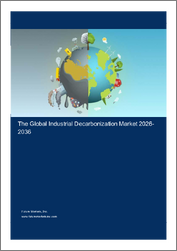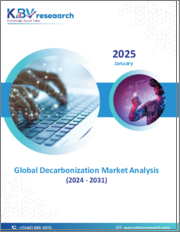
|
시장보고서
상품코드
1538268
해운 탈탄소화 시장 보고서 : 동향, 예측, 경쟁 분석(-2030년)Maritime Decarbonization Market Report: Trends, Forecast and Competitive Analysis to 2030 |
||||||
해운 탈탄소화 동향과 예측
세계의 해운 탈탄소화 시장은 2024-2030년 CAGR이 8.2%로, 2030년까지 추정 223억 달러에 달할 것으로 예상됩니다. 이 시장의 주요 촉진요인은 기후 변화에 대한 인식이 높아지고 환경 규제가 강화됨에 따라 업계가 더 깨끗한 기술로 전환하고 있으며, 각국 정부가 탄소 가격 책정, 녹색 회랑, 청정 기술에 대한 보조금과 같은 인센티브를 전 세계에서 시행하고 있다는 점입니다. 하고 있습니다. 세계 해운 탈탄소화 시장의 미래는 선박 및 항만 시장에서의 기회로 인해 유망합니다.
부문별 해운 탈탄소화
이 조사에는 전 세계 해운 탈탄소화 유형별, 용도별, 지역별 예측이 포함되어 있습니다.
해운 탈탄소화 시장 인사이트
Lucintel은 예측 기간 중 수소가 가장 높은 성장세를 보일 것으로 예상하고 있습니다.
무역 관련 협정 증가와 해운업계의 제품 및 솔루션 운송량 증가로 인해 선박은 이 시장에서 더 큰 비중을 차지할 것입니다.
북미는 환경 지속가능성에 대한 관심이 높아지고 온실가스 배출을 줄여야 할 필요성이 증가함에 따라 예측 기간 중 가장 규모가 큰 지역으로 남을 것으로 보입니다.
자주 묻는 질문
Q1. 시장 규모 :
A1. 세계 해운 탈탄소화 시장은 2030년까지 223억 달러에 달할 것으로 예상됩니다.
Q2. 시장의 성장 예측은 :
A2. 세계 해운 탈탄소화 시장은 2024-2030년 연평균 8.2%의 성장률을 보일 것으로 예상됩니다.
Q3. 시장의 성장에 영향을 미치는 주요 촉진요인은 :
A3. 이 시장의 주요 촉진요인은 기후 변화에 대한 인식이 높아지고 환경 규제가 강화되면서 청정 기술 산업을 촉진하고 있으며, 각국 정부가 탈탄소화 정책, 탄소 가격제, 그린 코리도, 청정 기술 보조금과 같은 인센티브를 전 세계에서 시행하고 있다는 점입니다. 인센티브를 전 세계에서 시행하고 있습니다.
Q4. 시장의 주요 부문은 :
A4. 세계 해운 탈탄소화 시장의 미래는 선박 시장과 항만 시장에 기회가 있고 유망합니다.
Q5. 시장의 주요 기업은 :
A5. 주요 해운 탈탄소화 기업은 다음과 같습니다.
- Wartsila
- Maersk
- CMA CGM
- Shell
Q6. 향후 최대가 되는 시장 부문은 :
A6.Lucintel은 예측 기간 중 수소가 가장 높은 성장세를 보일 것으로 예상했습니다.
Q7. 시장에서 향후 5년간 최대가 될 것으로 예상되는 지역은 :
A7. 북미는 환경 지속가능성에 대한 관심이 높아지고 온실가스 감축에 대한 필요성이 증가함에 따라 예측 기간 중 가장 규모가 큰 지역으로 남을 것입니다.
Q8. 리포트의 커스터마이즈는 가능한가? :
A8. 네. Lucintel은 추가 비용없이 10%의 커스터마이즈를 제공합니다.
목차
제1장 개요
제2장 세계의 해운 탈탄소화 시장 : 시장 역학
- 서론, 배경, 분류
- 공급망
- 업계의 촉진요인과 과제
제3장 2018-2030년 시장 동향과 예측 분석
- 거시경제 동향(2018-2023년)과 예측(2024-2030년)
- 세계의 해운 탈탄소화 시장의 동향(2018-2023년)과 예측(2024-2030년)
- 세계의 해운 탈탄소화 시장(유형별)
- 그린 암모니아
- 수소
- 바이오 메탄올
- 세계의 해운 탈탄소화 시장(용도별)
- 선박
- 항만
- 기타
제4장 2018-2030년 지역별 시장 동향과 예측 분석
- 세계의 해운 탈탄소화 시장 : 지역별
- 북미의 해운 탈탄소화 시장
- 유럽의 해운 탈탄소화 시장
- 아시아태평양의 해운 탈탄소화 시장
- 기타 지역의 해운 탈탄소화 시장
제5장 경쟁 분석
- 제품 포트폴리오 분석
- 업무 통합
- Porter's Five Forces 분석
제6장 성장 기회와 전략 분석
- 성장 기회 분석
- 세계의 해운 탈탄소화 시장 성장 기회(유형별)
- 세계의 해운 탈탄소화 시장 용도별 성장 기회
- 지역별 세계 해운 탈탄소화 시장의 성장 기회
- 세계의 해운 탈탄소화 시장의 새로운 동향
- 전략 분석
- 신제품 개발
- 세계의 해운 탈탄소화 시장의 생산능력 확대
- 세계의 해운 탈탄소화 시장의 합병, 인수, 합병사업
- 인증과 라이선싱
제7장 주요 기업의 기업 개요
- Wartsila
- Maersk
- CMA CGM
- Shell
Maritime Decarbonization Trends and Forecast
The future of the global maritime decarbonization market looks promising with opportunities in the ship and port markets. The global maritime decarbonization market is expected to reach an estimated $22.3 billion by 2030 with a CAGR of 8.2% from 2024 to 2030. The major drivers for this market are growing awareness of climate change and stricter environmental regulations are pushing the industry towards cleaner technologies, as well as, governments are implementing their decarbonization policies and incentives, such as carbon pricing, green corridors, and subsidies for clean technology globally.
A more than 150-page report is developed to help in your business decisions. Sample figures with some insights are shown below.
Maritime Decarbonization by Segment
The study includes a forecast for the global maritime decarbonization by type, application, and region.
Maritime Decarbonization Market by Type [Shipment Analysis by Value from 2018 to 2030]:
- Green Ammonia
- Hydrogen
- Bio Methanol
Maritime Decarbonization Market by Application [Shipment Analysis by Value from 2018 to 2030]:
- Ship
- Ports
- Others
Maritime Decarbonization Market by Region [Shipment Analysis by Value from 2018 to 2030]:
- North America
- Europe
- Asia Pacific
- The Rest of the World
List of Maritime Decarbonization Companies
Companies in the market compete on the basis of product quality offered. Major players in this market focus on expanding their manufacturing facilities, R&D investments, infrastructural development, and leverage integration opportunities across the value chain. With these strategies maritime decarbonization companies cater increasing demand, ensure competitive effectiveness, develop innovative products & technologies, reduce production costs, and expand their customer base. Some of the maritime decarbonization companies profiled in this report include-
- Wartsila
- Maersk
- CMA CGM
- Shell
Maritime Decarbonization Market Insights
Lucintel forecasts that hydrogen is expected to witness the highest growth over the forecast period.
Within this market, ship will remain larger segment due to growth in trade-related agreements as well as an increase in the transfer of products and solutions through the marine sector.
North America will remain the largest region over the forecast period due to increasing emphasis on environmental sustainability and the need to reduce greenhouse gas emissions.
Features of the Global Maritime Decarbonization Market
Market Size Estimates: Maritime decarbonization market size estimation in terms of value ($B).
Trend and Forecast Analysis: Market trends (2018 to 2023) and forecast (2024 to 2030) by various segments and regions.
Segmentation Analysis: Maritime decarbonization market size by type, application, and region in terms of value ($B).
Regional Analysis: Maritime decarbonization market breakdown by North America, Europe, Asia Pacific, and Rest of the World.
Growth Opportunities: Analysis of growth opportunities in different type, application, and regions for the maritime decarbonization market.
Strategic Analysis: This includes M&A, new product development, and competitive landscape of the maritime decarbonization market.
Analysis of competitive intensity of the industry based on Porter's Five Forces model.
FAQ
Q1. What is the maritime decarbonization market size?
Answer: The global maritime decarbonization market is expected to reach an estimated $22.3 billion by 2030.
Q2. What is the growth forecast for maritime decarbonization market?
Answer: The global maritime decarbonization market is expected to grow with a CAGR of 8.2% from 2024 to 2030.
Q3. What are the major drivers influencing the growth of the maritime decarbonization market?
Answer: The major drivers for this market are growing awareness of climate change and stricter environmental regulations are pushing the industry towards cleaner technologies, as well as, governments are implementing their decarbonization policies and incentives, such as carbon pricing, green corridors, and subsidies for clean technology globally.
Q4. What are the major segments for maritime decarbonization market?
Answer: The future of the global maritime decarbonization market looks promising with opportunities in the ship and port markets.
Q5. Who are the key maritime decarbonization market companies?
Answer: Some of the key maritime decarbonization companies are as follows:
- Wartsila
- Maersk
- CMA CGM
- Shell
Q6. Which maritime decarbonization market segment will be the largest in future?
Answer: Lucintel forecasts that hydrogen is expected to witness the highest growth over the forecast period.
Q7. In maritime decarbonization market, which region is expected to be the largest in next 5 years?
Answer: North America will remain the largest region over the forecast period due to increasing emphasis on environmental sustainability and the need to reduce greenhouse gas emissions.
Q.8 Do we receive customization in this report?
Answer: Yes, Lucintel provides 10% customization without any additional cost.
This report answers following 11 key questions:
- Q.1. What are some of the most promising, high-growth opportunities for the maritime decarbonization market by type (green ammonia, hydrogen, and bio methanol), application (ship, ports, and others), and region (North America, Europe, Asia Pacific, and the Rest of the World)?
- Q.2. Which segments will grow at a faster pace and why?
- Q.3. Which region will grow at a faster pace and why?
- Q.4. What are the key factors affecting market dynamics? What are the key challenges and business risks in this market?
- Q.5. What are the business risks and competitive threats in this market?
- Q.6. What are the emerging trends in this market and the reasons behind them?
- Q.7. What are some of the changing demands of customers in the market?
- Q.8. What are the new developments in the market? Which companies are leading these developments?
- Q.9. Who are the major players in this market? What strategic initiatives are key players pursuing for business growth?
- Q.10. What are some of the competing products in this market and how big of a threat do they pose for loss of market share by material or product substitution?
- Q.11. What M&A activity has occurred in the last 5 years and what has its impact been on the industry?
Table of Contents
1. Executive Summary
2. Global Maritime Decarbonization Market : Market Dynamics
- 2.1: Introduction, Background, and Classifications
- 2.2: Supply Chain
- 2.3: Industry Drivers and Challenges
3. Market Trends and Forecast Analysis from 2018 to 2030
- 3.1. Macroeconomic Trends (2018-2023) and Forecast (2024-2030)
- 3.2. Global Maritime Decarbonization Market Trends (2018-2023) and Forecast (2024-2030)
- 3.3: Global Maritime Decarbonization Market by Type
- 3.3.1: Green Ammonia
- 3.3.2: Hydrogen
- 3.3.3: Bio Methanol
- 3.4: Global Maritime Decarbonization Market by Application
- 3.4.1: Ship
- 3.4.2: Ports
- 3.4.3: Others
4. Market Trends and Forecast Analysis by Region from 2018 to 2030
- 4.1: Global Maritime Decarbonization Market by Region
- 4.2: North American Maritime Decarbonization Market
- 4.2.1: North American Maritime Decarbonization Market by Type: Green Ammonia, Hydrogen, and Bio Methanol
- 4.2.2: North American Maritime Decarbonization Market by Application: Ship, Ports, and Others
- 4.3: European Maritime Decarbonization Market
- 4.3.1: European Maritime Decarbonization Market by Type: Green Ammonia, Hydrogen, and Bio Methanol
- 4.3.2: European Maritime Decarbonization Market by Application: Ship, Ports, and Others
- 4.4: APAC Maritime Decarbonization Market
- 4.4.1: APAC Maritime Decarbonization Market by Type: Green Ammonia, Hydrogen, and Bio Methanol
- 4.4.2: APAC Maritime Decarbonization Market by Application: Ship, Ports, and Others
- 4.5: ROW Maritime Decarbonization Market
- 4.5.1: ROW Maritime Decarbonization Market by Type: Green Ammonia, Hydrogen, and Bio Methanol
- 4.5.2: ROW Maritime Decarbonization Market by Application: Ship, Ports, and Others
5. Competitor Analysis
- 5.1: Product Portfolio Analysis
- 5.2: Operational Integration
- 5.3: Porter's Five Forces Analysis
6. Growth Opportunities and Strategic Analysis
- 6.1: Growth Opportunity Analysis
- 6.1.1: Growth Opportunities for the Global Maritime Decarbonization Market by Type
- 6.1.2: Growth Opportunities for the Global Maritime Decarbonization Market by Application
- 6.1.3: Growth Opportunities for the Global Maritime Decarbonization Market by Region
- 6.2: Emerging Trends in the Global Maritime Decarbonization Market
- 6.3: Strategic Analysis
- 6.3.1: New Product Development
- 6.3.2: Capacity Expansion of the Global Maritime Decarbonization Market
- 6.3.3: Mergers, Acquisitions, and Joint Ventures in the Global Maritime Decarbonization Market
- 6.3.4: Certification and Licensing
7. Company Profiles of Leading Players
- 7.1: Wartsila
- 7.2: Maersk
- 7.3: CMA CGM
- 7.4: Shell
(주말 및 공휴일 제외)


















